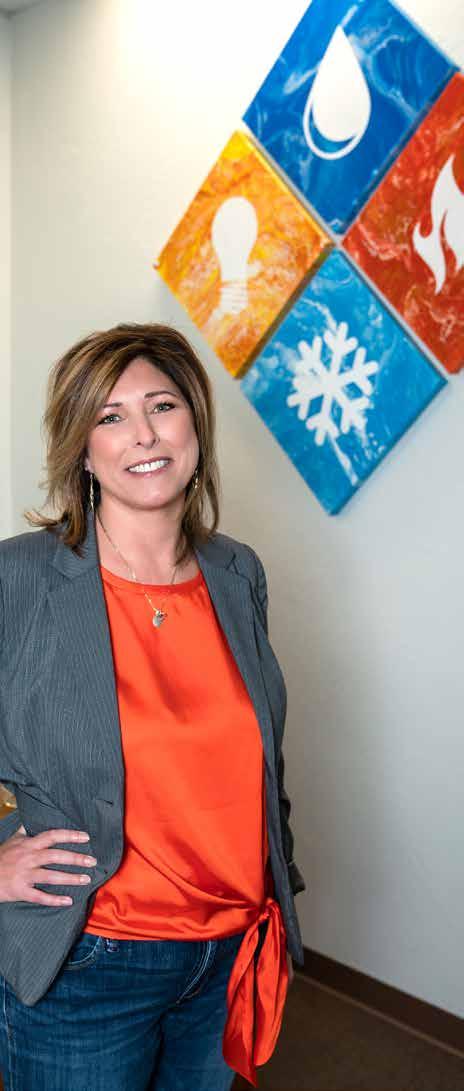
6 minute read
A TRIBUTE A TRIBUTE A TRIBUTE

TO AMERICA’S INFORMAL CAREGIVERS
Advertisement
In past articles written for My Vegas magazine, I discussed my premise which suggests knowing more personal stories about the 53 million Americans caring for loved ones in their homes, would encourage respect and recognition for those who serve in this role. Varied sources measured stress in caregivers and reported a majority of Informal Caregivers experience stress. Some sources, (LeRoy, 2014), reporting if this stress becomes continuous and lasts over several years, the Informal Caregiver can develop “Caregiver Syndrome.” This syndrome is not formally recognized. If recognized, would it lead to Informal Caregivers being stigmatized? Yet, no belief in this syndrome has led to a lack of formal education on ways to assist Informal Caregivers dealing with stress.
body. The stroke also left him with difficulty expressing himself. Maggie has been his caregiver, his sister, and perhaps most importantly, his advocate.
The caregiver role was not new to Maggie. She recalls life as a pre-teen after her father left. She realized even then her mother needed emotional support. Eventually, her father returned home. She was able to leave, and experience life as an adult. She married twice, both marriages failed. She traveled for a job she loved, writing for a newspaper.
In my book, “Stories of Silent Sacrifice: A Tribute to America’s Informal Caregivers,” I asked each person I interviewed if they had stress and how they dealt with stress. Not surprisingly, they all reported very high, continuous stress levels. In settings where there was no ‘getting out’ of the house when stress increased, several reported going to another room, closing the door, and sitting quietly for as long as it took to return to their acceptable stress levels.
One wife reported watching a movie on TV, while her husband slept, helped reduce her stress levels. She explained, she turned on closed captions - even though her hearing was fine. This made her pay attention to the story as it unfolded and feel like she had a break.
When I asked an older Informal Caregiver, who was providing full-time home care services to her adult son, she went down a more controversial path. She stated there should be a limit on the amount of time one could spend in this role. Her idea was to limit that time to two years. In reality, this may not be that outrageous of a suggestion. LeRoy (2014) reported Informal Caregivers over the age of 70, die before their care recipient 69% of the time. Perhaps, due to years of being subjected to stress hormones. Even younger Informal Caregivers develop serious, life-threatening illnesses, while in this role.
In a 2020 press release, the AARP announced our country had 53 million informal caregivers and estimated the value of the care they provide exceeded 400 billion dollars annually. Both of these astounding numbers have grown substantially, since AARP began monitoring the number of informal caregivers in our country. An informal caregiver is usually an unpaid individual who is providing the care and support a loved one needs to remain in their own home. Their duties can require several hours a week, to 24 hours a day. These caregivers go largely unnoticed, but they make up a growing army of unsung heroes in healthcare. A portion of that army resides in Las Vegas and its surrounding communities. Stories of Silent Sacrifice offers a glimpse into the lives of ten of them, as this writer attempts to personalize their role. Perhaps seeing these informal caregivers in a personal light, our population and our health care providers will become more aware of their contributions to healthcare. What might we do to help them? Caregivers in this book care for persons that require fulltime care. I plan to use my assigned page in this and upcoming editions of MyVegas, to highlight several of these
Maggie was living in Arizona when her brother moved back to their parents’ home. One day, his estranged wife asked Maggie to go to that house and find him. Maggie found him on the floor of his room. She could see he had experienced a stroke. When he recovered, to the degree he would recover, he asked if he could live with her. She recalled a time in her early teens when she needed love and support, and he was the only one there. She agreed.
Although Informal Caregivers agree periods of respite help prepare them to return to their role, some report their care recipient will not agree to others caring for them. Several of the caregivers in my book cited their pets getting them through stressful times. Others felt Yoga classes helped. All reported the basic premise of support or just contact from friends and family, helped them feel less isolated and have less stress.
While our community healthcare sources argue the need to recognize the possibility of “Caregiver Syndrome,” it would appear there is much we could be doing as friends and family members of an Informal Caregiver. A call, a card, even flowers or an offer to shop or provide brief respite in the home, are all potential stress relievers.
Dr. Rosemary Henrich, DNP, FNP
Source: CNN, article by Andree LeRoy, M. D., 2014.
Most informal caregivers are family members of the person whose care they are providing. This is true of Maggie, who is the fulltime caregiver for her older brother who has survived a stroke. This stroke left him unable to move one side of his
Maggie tells her life story interjecting many humorous events, along with all the emotional trauma she has been through. She believes she was always meant to be a caregiver, but urges those who are considering this role, to know that the most important thing is to love the person they are caring for. This sentiment is echoed by all the caregivers featured in the book, Stories of Silent Sacrifice. – Dr. Rosemary Henrich, DNP
Born and raised in Ohio, Stacie Lang grew up with an entrepreneurial spirit as her father ran a business of his own. She once dreamed that she would work side-byside with her father and take over the business. Alas, the family business was sold, and she would need to pursue different career aspirations. In her search for new career opportunities, she landed where many teenagers land, working at the local McDonald’s. There she learned all the foundational business processes but developed a passion for taking care of and developing people. “I have always believed that the success of any company starts with the people at the bottom. Without them, the business doesn’t work. We have to take care of them and bring them up and it will bring everyone up.”
Not only did she learn the foundation of business while working at McDonald’s, but she also met her husband of 19 years. After leaving the restaurant industry, Stacie and her family moved to California. Her focus shifted from business to family and education, as she spent years both raising small children and going to college full-time. In 2010, she graduated with a Masters in Organizational Leadership and Development.

The move to Las Vegas in 2011 was a pivotal moment for Stacie. This was a new chapter and the opportunity for new professional ventures. “I like to stay busy. I needed to find more things to do.” She wanted to fill her time with other meaningful work, so she started volunteering with the Ronald McDonald House Charities. She was quickly hired on to be the Volunteer Manager and within 6 months, she became the Director of Operations. Not only did this experience create a passion for non-profit work, but her oversight of the RMHC remodel was her introduction into the world of home services.
After several years of working within the home services industry, Stacie took the next step to return to the dream of owning her own business. Along with business partner, Jeremy Anderson, Green Bird Consulting was born with the idea that there is a better way of developing the non-profit and home services industries. From its inception, Green Bird worked with Junior League of Las Vegas, Trail Access Project, League of Women Voters, SNARSCA, Code Blue HVAC, and other small businesses/charities within the valley to help them build strong strategic initiatives.
The only logical next step after starting to develop others, was to enter the industry as a contractor. Today, Stacie is the owner and Chief Financial Officer of Express Home Services, working alongside her business partner Jeremy Anderson. The company specializes in air conditioning, plumbing, and electrical home services and is located both in Las Vegas as well as Salt Lake City. “We started this company because we knew there was a better way to do this. We built a model on employees winning, clients winning, and when done right, the business follows suit. We love our team, we love our clients, we love what we do.”










